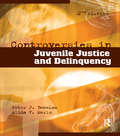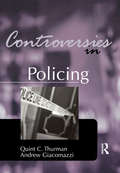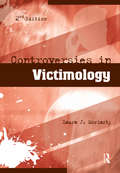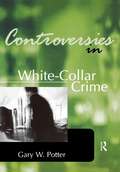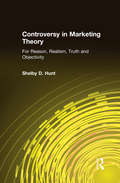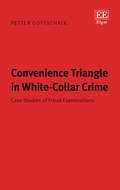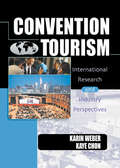- Table View
- List View
Controversies in Juvenile Justice and Delinquency
by Peter J. Benekos Alida V. MerloAfter providing a history of the development of the juvenile court, this book explores some of the most important current controversies in juvenile justice. Original essays review major theories of juvenile delinquency, explore psychological and biological factors that may explain delinquent behavior, and examine the nexus between substance abuse and delinquency. A final chapter provides a comparative analysis.
Controversies in Management: Issues, Debates, Answers
by Alan B ThomasAs managerial roles diversify, the phenomenon of management becomes increasingly puzzling. Demand for formal management training, theories and qualifications has increased, yet our ability to think critically about management has diminished. At a time of organizational and environmental turbulence, the question of effective management is more complex than ever. Unpicking the puzzles faced by both the manager and the student of management, this introductory guide explores the major issues of management, organization and knowledge, asking questions of our 'guru' culture and raising debates on so-called expert thinking. Written from the viewpoint that the most effective managers are those that can think for themselves and put aside the advice of the management 'guru', it is a topical, challenging and thought-provoking study. Thoroughly revised and reorganized, this second edition features two completely new chapters that cover gender issues in management, debates on globalization, post-modernity and the future of management. Designed to bring readers into the debate, rather than simply providing a framework of answers, this new edition also includes an orientation questionnaire, discussion questions for each area covered and further reading suggestions.
Controversies in Management: Issues, Debates, Answers
by Alan B ThomasAs managerial roles diversify, the phenomenon of management becomes increasingly puzzling. Demand for formal management training, theories and qualifications has increased, yet our ability to think critically about management has diminished. At a time of organizational and environmental turbulence, the question of effective management is more complex than ever. Unpicking the puzzles faced by both the manager and the student of management, this introductory guide explores the major issues of management, organization and knowledge, asking questions of our 'guru' culture and raising debates on so-called expert thinking. Written from the viewpoint that the most effective managers are those that can think for themselves and put aside the advice of the management 'guru', it is a topical, challenging and thought-provoking study. Thoroughly revised and reorganized, this second edition features two completely new chapters that cover gender issues in management, debates on globalization, post-modernity and the future of management. Designed to bring readers into the debate, rather than simply providing a framework of answers, this new edition also includes an orientation questionnaire, discussion questions for each area covered and further reading suggestions.
Controversies in Policing (Controversies In Crime And Justice Ser.)
by Quint Thurman Andrew GiacomazziThis book of original essays presents controversial topics, then encourages the readers to consider what they think ought to be done. The selections identify several of the existing issues in policing about which something needs to be done; then, they present various viewpoints on possible solutions. This is done against the backdrop of an era of significant change in worldwide security, post-9/11, that has caused major changes in the manner in which the U.S. conducts its political, social and economic affairs.
Controversies in Policing
by Quint Thurman Andrew GiacomazziThis book of original essays presents controversial topics, then encourages the readers to consider what they think ought to be done. The selections identify several of the existing issues in policing about which something needs to be done; then, they present various viewpoints on possible solutions. This is done against the backdrop of an era of significant change in worldwide security, post-9/11, that has caused major changes in the manner in which the U.S. conducts its political, social and economic affairs.
Controversies in Victimology (Controversies In Crime And Justice Ser.)
by Laura J. MoriartyControversies in Victimology features original works of noted scholars and practitioners, aiming to shed light on the debates over, the media attention on, and the psychology behind victimization. This book discusses the controversies from all sides of the debate, and attempts to reconcile the issues in order to move the field forward.
Controversies in Victimology
by Laura J. MoriartyControversies in Victimology features original works of noted scholars and practitioners, aiming to shed light on the debates over, the media attention on, and the psychology behind victimization. This book discusses the controversies from all sides of the debate, and attempts to reconcile the issues in order to move the field forward.
Controversies in White-Collar Crime (Controversies In Crime And Justice Ser.)
by Gary PotterOriginal writings explore the issue of white-collar crime and the controversies that surround it, focusing on the vastness of state-corporate and white-collar crime, the victimization that results, and the ways these crimes affect society environmentally, politically, economically and personally.
Controversies in White-Collar Crime
by Gary PotterOriginal writings explore the issue of white-collar crime and the controversies that surround it, focusing on the vastness of state-corporate and white-collar crime, the victimization that results, and the ways these crimes affect society environmentally, politically, economically and personally.
Controversy in Marketing Theory: For Reason, Realism, Truth and Objectivity
by Shelby D. HuntIn this book distinguished theorist and author Shelby D. Hunt analyzes the major controversies in the "philosophy debates" raging throughout the field of marketing. Using an historical approach, Hunt argues against relativism and for scientific realism as a philosophy for guiding marketing research and theory. He also shows how the pursuit of truth and objectivity in marketing research are both possible and desirable. Specific controversies analyzed in the book include: Does positivism dominate marketing research? Does positivism imply quantitive methods? Is relativism an appropriate foundation for marketing research? Does relativism imply pluralism, tolerance, and openness? Should marketing pursue the goal of objective research? An ideal companion to Hunt's classic text, Foundations of Marketing Theory, this volume will be equally useful on its own in any graduate level course on marketing theory.
Controversy in Marketing Theory: For Reason, Realism, Truth and Objectivity
by Shelby D. HuntIn this book distinguished theorist and author Shelby D. Hunt analyzes the major controversies in the "philosophy debates" raging throughout the field of marketing. Using an historical approach, Hunt argues against relativism and for scientific realism as a philosophy for guiding marketing research and theory. He also shows how the pursuit of truth and objectivity in marketing research are both possible and desirable. Specific controversies analyzed in the book include: Does positivism dominate marketing research? Does positivism imply quantitive methods? Is relativism an appropriate foundation for marketing research? Does relativism imply pluralism, tolerance, and openness? Should marketing pursue the goal of objective research? An ideal companion to Hunt's classic text, Foundations of Marketing Theory, this volume will be equally useful on its own in any graduate level course on marketing theory.
The Conundrum of Russian Capitalism: The Post-Soviet Economy in the World System
by Ruslan DzarasovThe fall of the Soviet Union and the emergence of contemporary Russian capitalism are often all too often read as a juncture with the past. In reality, Russia's current capitalist system originated in the degenerated Soviet bureaucracy, alongside the pressures of global capital. *BR**BR*From Roman Abramovich to Leonid Mikhelson, the reign of the CEO in Russia corporations mirrors the autocracy of the Soviet Union's leaders: the Russian tradition of the Cult of Personality lives on. The conception of the massive corporations, and the autocrats that lead them, occurred towards the end of the Soviet Union, when the would-be owners seized corporate assets and, taking advantage of Gorbachev's reforms, transformed publicly owned industry into private enterprises with themselves at the helm. By comparing the practices of Russian corporate governance, labour practices and investment strategies to the typical models of corporate governance and investment behaviour of big firms in the West, Ruslan Dzarasov exposes the parallels between the core and the periphery of the capitalist world-system.*BR**BR*Drawing on the theory of Leon Trotsky, as well as Immanuel Wallerstein and Robert Brenner, this study disrupts many of the myths about Russia's political economy. *BR*
The Conundrum of Russian Capitalism: The Post-Soviet Economy in the World System
by Ruslan DzarasovThe fall of the Soviet Union and the emergence of contemporary Russian capitalism are often all too often read as a juncture with the past. In reality, Russia's current capitalist system originated in the degenerated Soviet bureaucracy, alongside the pressures of global capital. *BR**BR*From Roman Abramovich to Leonid Mikhelson, the reign of the CEO in Russia corporations mirrors the autocracy of the Soviet Union's leaders: the Russian tradition of the Cult of Personality lives on. The conception of the massive corporations, and the autocrats that lead them, occurred towards the end of the Soviet Union, when the would-be owners seized corporate assets and, taking advantage of Gorbachev's reforms, transformed publicly owned industry into private enterprises with themselves at the helm. By comparing the practices of Russian corporate governance, labour practices and investment strategies to the typical models of corporate governance and investment behaviour of big firms in the West, Ruslan Dzarasov exposes the parallels between the core and the periphery of the capitalist world-system.*BR**BR*Drawing on the theory of Leon Trotsky, as well as Immanuel Wallerstein and Robert Brenner, this study disrupts many of the myths about Russia's political economy. *BR*
Convection in Porous Media
by D.A. Nield Adrian BejanIn this book we have tried to provide a user-friendly introduction to the topic of convection in porous media. We have assumed that the reader is conversant with the basic elements of fluid mechanics and heat transfer, but otherwise the book is self-contained. Only routine classical mathematics is employed. We hope that the book will be useful both as a review (for reference) and as a tutorial work (suitable as a textbook in a graduate course or seminar). This book brings into perspective the voluminous research that has been performed during the last two decades. The field has recently exploded because of worldwide concern with issues such as energy self-sufficiency and pollution of the environment. Areas of application include the insulation of buildings and equipment, energy storage and recovery, geothermal reservoirs, nuclear waste disposal, chemical reactor engineering, and the storage of heat-generating materials such as grain and coal. Geophysical applications range from the flow of groundwater around hot intrusions to the stability of snow against avalanches.
Convection in Porous Media
by D.A. Nield Adrian BejanA user-friendly introduction to convection in porous media, such as fibrous insulation, geological strata, and catalytic reactors. This is a self-contained presentation, requiring only routine classical mathematics and the basic elements of fluid mechanics and heat transfer. It will thus be of use not only to researchers and practising engineers as a review and reference, but also to graduates and others just entering the field. Applications discussed include such disparate topics as building insulation, energy storage, nuclear-waste disposal, coal and grain storage, chemical reactor engineering, groundwater flow, and stability of snow to avalanches. In this second edition the authors have added: discussions of compact heat exchangers and of tree networks; new material on external natural convection; descriptions of the effects of magnetic fields, of rotations, and of periodic heating; discussions of inclined gradients and of the solidification of alloys; and an extensive treatment of two-phase flows. An extensive list of references -- emphasising recent experimental work -- provides access to the current research literature.
Convection in Porous Media
by D.A. Nield Adrian BejanThis new edition includes nearly 1000 new references.
Convenience Triangle in White-Collar Crime: Case Studies of Fraud Examinations
by Petter GottschalkStudies have shown that the number of individuals being incarcerated for white-collar crime is on the rise, going hand-in-hand with an increase in support for punishment and imprisonment for white-collar offenders among the public. This book aims to discuss the role of the ‘convenience triangle’ in white-collar crime, how it affects the perpetration of these crimes, the impact of this on detection and prevention and the effects of the punitive measures taken against white-collar criminals. The ‘convenience triangle’ is the dynamic relationship between motive, opportunity, and willingness to commit a crime, which culminates in the illegal acts that constitute white-collar crime. The relationship between these factors is explored through case studies highlighting each of these six causal relationships. Alongside this, the role of whistleblowing in the detection of white-collar crime, and the issue of incarceration for white collar criminals are discussed. For students of business and management, this book will provide valuable insights into the motivation and practice of white-collar crime. Its insights and discussion will also prove valuable for practitioners, engaged in both management and crime prevention.
Convention Tourism: International Research and Industry Perspectives
by Kaye Sung Chon Karin WeberStay up to date on international trends in convention tourism! Convention Tourism: International Research and Industry Perspectives is a thorough analysis of the industry’s key markets, combining insightful articles with detailed case studies. Equally valuable as a professional handbook, research reference guide, and textbook, this comprehensive book includes an account of the history of convention tourism and its economic contributions, marketing and human resources analyses, global and regional developments, and research issues and challenges. Convention Tourism addresses issues critical to the three key regions of the convention and meeting industry--North America, Europe, and Asia-Pacific. The book features a wide range of material from the top educators around the world, reflecting an international perspective befitting the industry’s growing trend toward globalization. Convention Tourism also presents in-depth studies that focus on the United States, the Mediterranean, Australia, and Korea, and takes a look ahead at likely business, technological, and social trends that are likely to affect the convention industry in the coming years. Convention Tourism also examines: proposed economic impact assessment framework regional planning and development initiatives education and training programs from industry associations and universities research resources international meeting managementAs more and more international sites compete with traditional markets for lucrative convention contracts, it is crucial that professionals, researchers, and academics have a global understanding of the industry’s past, present, and future. Convention Tourism is an essential overview of the most important element of the business tourism industry.
Convention Tourism: International Research and Industry Perspectives
by Kaye Sung Chon Karin WeberStay up to date on international trends in convention tourism! Convention Tourism: International Research and Industry Perspectives is a thorough analysis of the industry’s key markets, combining insightful articles with detailed case studies. Equally valuable as a professional handbook, research reference guide, and textbook, this comprehensive book includes an account of the history of convention tourism and its economic contributions, marketing and human resources analyses, global and regional developments, and research issues and challenges. Convention Tourism addresses issues critical to the three key regions of the convention and meeting industry--North America, Europe, and Asia-Pacific. The book features a wide range of material from the top educators around the world, reflecting an international perspective befitting the industry’s growing trend toward globalization. Convention Tourism also presents in-depth studies that focus on the United States, the Mediterranean, Australia, and Korea, and takes a look ahead at likely business, technological, and social trends that are likely to affect the convention industry in the coming years. Convention Tourism also examines: proposed economic impact assessment framework regional planning and development initiatives education and training programs from industry associations and universities research resources international meeting managementAs more and more international sites compete with traditional markets for lucrative convention contracts, it is crucial that professionals, researchers, and academics have a global understanding of the industry’s past, present, and future. Convention Tourism is an essential overview of the most important element of the business tourism industry.
Conventional Water Resources and Agriculture in Egypt (The Handbook of Environmental Chemistry #74)
by Abdelazim M. NegmThis unique volume focuses on Egypt’s conventional water resources and the main water consumer: Egypt’s agriculture. It provides an up-to-date overview and the latest research findings, and covers the following main topics: · History of irrigation and irrigation projects · Key features of agriculture, the administrative and legal framework in Egypt · Land resources for agriculture development · Food insecurity due to water shortages and climate change; resulting challenges and opportunities · Assessment of water resources for irrigation and drinking purposes · Impacts of upstream dams, such as the GERD and Tekeze Dam, on Egypt’s water resources and crop yield · Sustainable use of water resources and the future of mega irrigation projects · Quantity and quality of water in Egypt’s water resources bank This book and the companion volume Unconventional Water Resources and Agriculture in Egypt offer invaluable reference guides for postgraduates, researchers, professionals, environmental managers and policymakers interested in water resources and their management worldwide.
Convergence: The Redesign of Design (AD Smart)
by Randy Deutsch"There is today a pronounced and accelerated convergence in architecture. This convergence is occurring by doers not thinkers; in practice not academia; in building design, fabrication, and construction. It is about solution-centric individuals engaged in real time problem solving, not in abstractions. The nature of this convergence, where things are converging and what that means for architecture, is the subject of this book."—from the IntroductionThose working in architecture and engineering feel pressure to work faster, at lower cost, while maintaining a high level of innovation and quality. At the same time, emergent tools and processes make this possible. Convergence is about the firms, teams and people who thrive in this environment as a result of their ability to creatively combine and innovate. It seeks to answer several timely questions: What are the tools and work processes that are converging? How are individuals and organizations converging their tools and work processes? What challenges and benefits are they seeing? What is the ultimate endgame of this convergence? What skillsets and mindsets would someone need to develop to work effectively in this changing environment? What are the implications of convergence on the role of the designer, and on design? On how we design, build, fabricate, and construct? On how we work? The book explains how convergence relates to, but ultimately differs from integration, consolidation, multi-tasking, automation, and other forms of optimization. The practice-based research builds upon the author’s research in BIM and in the collaborative leveraging of data in design and fabrication. As an investigation and meditation on the impact of technology on the education and making of design professionals Convergence explains what is happening in the world of design, and discusses the implications for the future of education, training and practice.
Convergence: The Redesign of Design (AD Smart)
by Randy Deutsch"There is today a pronounced and accelerated convergence in architecture. This convergence is occurring by doers not thinkers; in practice not academia; in building design, fabrication, and construction. It is about solution-centric individuals engaged in real time problem solving, not in abstractions. The nature of this convergence, where things are converging and what that means for architecture, is the subject of this book."—from the IntroductionThose working in architecture and engineering feel pressure to work faster, at lower cost, while maintaining a high level of innovation and quality. At the same time, emergent tools and processes make this possible. Convergence is about the firms, teams and people who thrive in this environment as a result of their ability to creatively combine and innovate. It seeks to answer several timely questions: What are the tools and work processes that are converging? How are individuals and organizations converging their tools and work processes? What challenges and benefits are they seeing? What is the ultimate endgame of this convergence? What skillsets and mindsets would someone need to develop to work effectively in this changing environment? What are the implications of convergence on the role of the designer, and on design? On how we design, build, fabricate, and construct? On how we work? The book explains how convergence relates to, but ultimately differs from integration, consolidation, multi-tasking, automation, and other forms of optimization. The practice-based research builds upon the author’s research in BIM and in the collaborative leveraging of data in design and fabrication. As an investigation and meditation on the impact of technology on the education and making of design professionals Convergence explains what is happening in the world of design, and discusses the implications for the future of education, training and practice.
Convergence: Proceedings of the International Conference on Healthcare Systems Ergonomics and Patient Safety, HEPS2022 (Springer Series in Design and Innovation #30)
by Marijke Melles Armaĝan Albayrak Richard H. M. GoossensThis book presents the proceedings of the 7th conference Healthcare Systems Ergonomics and Patient Safety (HEPS), held in Delft, The Netherlands on November 2-4, 2022, which was endorsed by the International Ergonomics Association (IEA). Contributions focus on the integration of knowledge, methods, and expertise from the disciplines of Human Factors/Ergonomics and of Medicine and Health in order to contribute to a safe and humane, high-quality healthcare system. Through breaking down the barriers between disciplines, they foster a framework of scientific knowledge, expertise and best practices to create the future of health and healthcare. The proceedings include papers from researchers and practitioners, scientists and physicians, institutional leaders, managers and policy makers that contribute to constructing the Human Factors and Ergonomics approach across a variety of methodologies, domains and productive sectors.
Convergence: An Architectural Agenda For Energy
by Kiel MoeConvergence is based on the thermodynamic premise that architecture should maximize its ecological and architectural power. No matter how paradoxical it might initially seem, architects should maximize energy intake, maximize energy use, and maximize energy feedback and reinforcement. This presumes that the necessary excess of architecture is in fact an architect’s greatest asset when it comes to an agenda for energy, not a liability. But how do we start to understand the full range of eco-thermodynamic principles which need to be engaged with in order to achieve this? Kiel Moe explicates three factors: materials, energy systems and amortization. When these three factors converge through design, the resulting buildings begin to perform in complex, if not subtle, ways. By drawing on a range of architectural, thermodynamic, and ecological sources as well as illustrated and well-designed case studies, the author shows what architecture stands to gain by simultaneously maximizing the architectural and ecological power of buildings. .
Convergence: An Architectural Agenda For Energy
by Kiel MoeConvergence is based on the thermodynamic premise that architecture should maximize its ecological and architectural power. No matter how paradoxical it might initially seem, architects should maximize energy intake, maximize energy use, and maximize energy feedback and reinforcement. This presumes that the necessary excess of architecture is in fact an architect’s greatest asset when it comes to an agenda for energy, not a liability. But how do we start to understand the full range of eco-thermodynamic principles which need to be engaged with in order to achieve this? Kiel Moe explicates three factors: materials, energy systems and amortization. When these three factors converge through design, the resulting buildings begin to perform in complex, if not subtle, ways. By drawing on a range of architectural, thermodynamic, and ecological sources as well as illustrated and well-designed case studies, the author shows what architecture stands to gain by simultaneously maximizing the architectural and ecological power of buildings. .
